Exploring the Significance of Crystal Ring Engagements
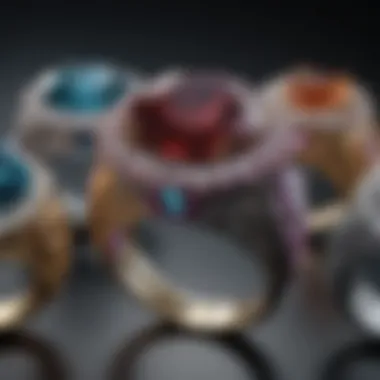
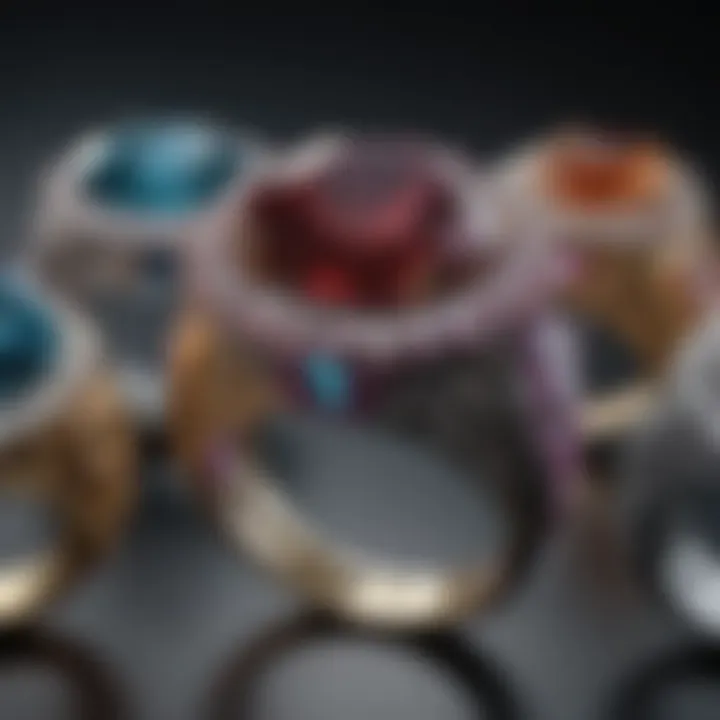
Intro
Engagement rings have long been a symbol of love and commitment. As couples explore unique expressions of their devotion, crystal rings emerge as a fascinating alternative to traditional diamond rings. The allure of these gemstones lies not only in their distinct beauty but also in their rich history and personal significance. In this article, we will embark on a journey through the mesmerizing world of crystal engagement rings. We’ll look at what sets them apart, their various styles, and meaningful considerations that can influence your choice.
Gemstone Overview
Definition and Characteristics
Crystals, in the realm of engagement rings, refer to formations of minerals that exhibit clarity and spark, similar to gemstones. A crystal is structured with a repeating pattern, exhibiting unique properties such as color, transparency, and brilliance, often regarded for their metaphysical attributes as well. Each type of crystal resonates with different energies that can be particularly meaningful to the wearer. For instance, a rose quartz is often associated with love and emotional healing, while amethyst symbolizes tranquility and balance.
These gemstones can be vibrant and colorful, unlike traditional diamonds that are predominantly clear. Crystals like aquamarine can capture waves of blue reminiscent of the ocean, while citrine shines bright with warm golden hues. Their physical characteristics, such as hardness and refractive index, are varied, affecting not only their appearance but also their durability in everyday wear.
Classification of Gemstones
Gemstones can be broadly classified into two categories: precious and semi-precious. While diamonds, rubies, sapphires, and emeralds fall under the precious category, many gorgeous crystals such as garnets, topaz, and tourmaline are considered semi-precious.
- Precious Gemstones
- Semi-Precious Gemstones
- Diamonds
- Rubies
- Sapphires
- Emeralds
- Amethyst
- Citrine
- Garnet
- Topaz
Each classification not only reflects market value but also carries cultural meanings. While precious stones are often seen as traditional, semi-precious stones allow for more personal and unique expressions in engagement rings.
Historical Significance
Ancient Uses and Cultural Importance
The use of crystals and gemstones throughout history is steeped in tradition. Ancient civilizations revered these stones for their aesthetic qualities and believed in their healing properties. The Egyptians, for instance, adorned themselves with lapis lazuli and turquoise, thinking these stones would offer protection and wisdom.
Moreover, crystals have found their way into rituals and royal engagements alike. Historical records suggest that certain stones were believed to enhance the traits of love and fidelity, making them popular choices for wedding and engagement jewelry.
Myths and Legends Surrounding Gemstones
Throughout the ages, various myths and legends have woven tales around different crystals. Take, for example, the lore surrounding the alexandrite crystal, which is said to change color in different lighting, symbolizing love’s duality. In folklore, the moonstone is linked to the ancient goddess of love, where wearing it was thought to invite romance.
"Crystals have a voice of their own, whispering truths about love, fate, and life’s mysteries through their colors and luster."
Understanding these tales and beliefs allows the seeker to appreciate the significance of their chosen engagement ring. It transforms a mere piece of jewelry into a bearer of stories and culture, making your engagement a blend of personal significance and rich history.
As we delve deeper into the specifics of selecting crystal engagement rings, it will become clear that these gemstones hold much weight beyond their visual appeal. Each choice comes with a history and a story waiting to be told.
Preface to Crystal Ring Engagements
Engagement rings have long been symbols of commitment and love, but the stones adorning them are evolving alongside our changing values and tastes. Crystal ring engagements bring a fresh perspective to a tradition often dominated by the brilliance of diamonds. The growing demand for meaningful alternatives reflects a shift towards personalization and uniqueness in jewelry, showcasing distinct qualities beyond mere aesthetics.
Choosing a crystal engagement ring opens a world of possibilities, from selecting a significant stone to creating a custom design that speaks to the couple’s journey. Not only are these rings often more affordable, but they also allow for deeper emotional connections—each crystal radiating its own story and meaning. In this article, we will explore various facets of crystal rings, considering not just their beauty but also the intentional choices behind them.
The Rise of Alternative Gemstones
In recent years, there has been a noticeable surge in the popularity of alternative gemstones for engagement rings. This trend reflects a desire for individuality and authenticity. As people seek rings that resonate personally, they are turning away from traditional diamonds, often regarded as a "one size fits all" choice.
- Personal Expression: Crystal rings align closely with personal style and aspirations. Whether it’s the soft hues of rose quartz or the rich deep tones of an amethyst, each stone carries its own vibe that reflects the persona of the wearer.
- Cultural Shift: In a world where sustainability is becoming crucial, many couples are now looking into ethically sourced options. Crystals often present a more eco-friendly choice than mined diamonds, with plenty of lab-created or recycled stones available.
- Affordability: The price tag of diamonds can often lead to financial strain. Crystals provide a wallet-friendly option, allowing couples to invest more in other aspects of their celebration or future, without sacrificing style.
With an array of unique qualities attributed to various stones, the allure of crystal engagement rings continues to pull in those searching for a deeper, more personalized meaning in their jewelry selection. Meetings, budgets, and personal stories blend into the choice of rings, giving a multi-dimensional space for couples to explore what represents their bond best.
"In this fast-paced world, a simple, meaningful ring can tell your love story better than a diamond ever could."
This approach not only enriches the act of engagement but fosters a culture appreciating craftsmanship, sentiment, and authenticity. As we dive deeper into the intricacies of gems utilized in these rings and the layers of meaning they hold, it will become clear just how significant crystal engagement rings can be.
Understanding Crystals
Understanding crystals is crucial when considering an engagement ring, particularly in the context of alternatives to traditional diamonds. Each type of crystal carries unique characteristics that influence their aesthetic appeal and symbolic significance. Knowing these details allows buyers to make educated choices that resonate with personal values and preferences.
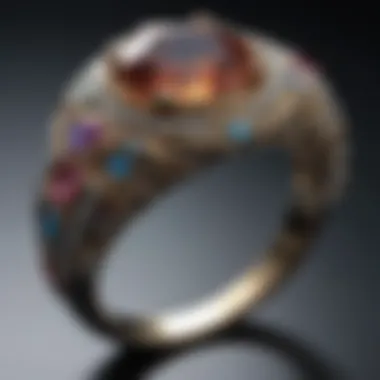
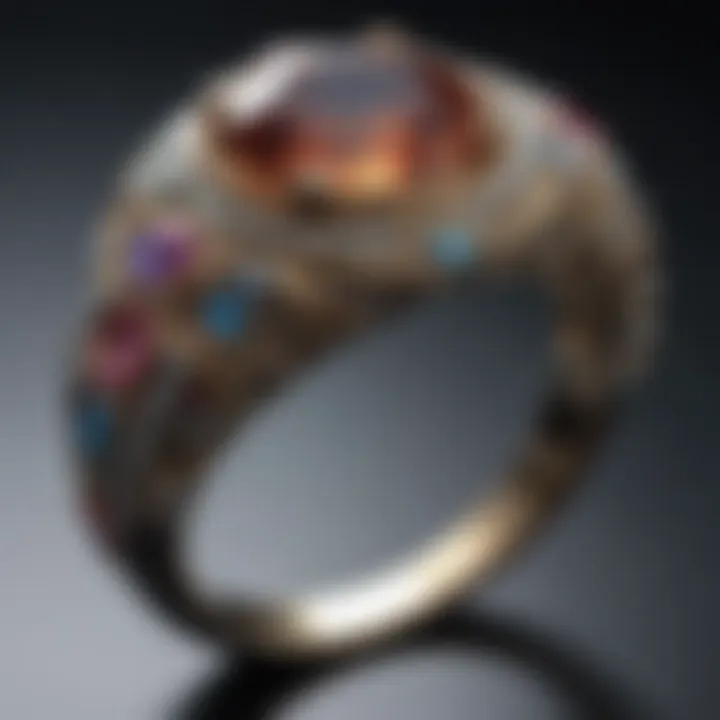
Types of Crystals Used in Engagement Rings
When selecting a crystal engagement ring, a few standout options often come to mind:
Quartz
Quartz stands as one of the most versatile gemstones around. Its beauty lies in its clarity and wide array of hues, offering everything from clear to smoky and rose tones. This adaptability makes quartz a quite popular choice for various styles of engagement rings. The main drop-dead gorgeous feature of quartz is its abundance. It’s readily available and much more affordable than its diamond counterpart. However, it's worth noting that while quartz has an enticing look, it ranks lower on hardness compared to other gems, making it prone to scratches, especially in daily wear.
Sapphire
Sapphires are widely recognized not just for their stunning blue color, but also for their strength and resilience. They are less likely to chip or scratch, which makes them a practical option for engagement rings. The key characteristic of sapphires is their durability, often earning an exceptional hardness rating on the Mohs scale. Beyond their physical properties, sapphires also bring a deep cultural significance, often symbolizing wisdom and nobility. However, the main downside to sapphires is their price point, which can be quite steep, depending on quality.
Topaz
Topaz showcases its versatility through a spectrum of colors, ranging from the well-known blue to a lovely pink or yellow. It’s often embraced for its affordability and vivid coloration, which adds a unique flair to engagement rings. The unique feature of topaz is its ability to be treated for enhanced color saturation, making it even more noble in appearance. However, it’s important to be cautious with topaz; it isn’t as hard as some other gemstones, possibly leading to wear over time if exposed to harsh conditions.
Amethyst
Amethyst is revered for its regal purple hue, typically associated with luxury and sophistication. Its key characteristic is that it’s an appealing choice for those who wish for a vibrant color without a hefty price tag. Amethyst rings are eye-catching and often speak to a modern, eclectic style. One unique feature Amethyst possesses is its color zoning, where different shades of purple appear naturally, providing depth. Conversely, due to its moderate hardness, it may require a bit more care to keep looking pristine.
Unique Properties of Crystals
Delving into the unique properties of crystals offers buyers a deeper appreciation of their choices beyond just appearance.
Clarity and Color
When talking about clarity and color, it’s all about what catches the eye. Many gemstones, like quartz and sapphire, are renowned for their striking clarity, which allows light to pass through, creating captivating sparkles. Color plays a pivotal role, as it can make or break the attractiveness of a ring. The unique feature of clarity is that it influences how brilliantly a crystal reflects light. This characteristic also affects pricing: clear, flawless stones are typically valued higher, making mindful selections essential for budget-conscious shoppers.
Hardness Ratings
The hardness rating is another vital consideration, particularly for everyday wear items like engagement rings. Hardness is gauged by the Mohs scale, which ranks materials from 1 (like talc) to 10 (like diamond). It's a good idea to choose a stone that suits your lifestyle. For instance, sapphires score high and can withstand daily rigors, while quartz's more modest score suggests careful handling. The unique feature of hardness ratings lies in their assurance; a more durable crystal means fewer worries about everyday wear and tear, allowing one to flaunt their ring without incessant concern.
Optical Phenomena
Crystals often exhibit fascinating optical properties that can add intrigue to an engagement ring. This includes phenomena such as asterism in star sapphires or the captivating plays of light found in opals. These key characteristics are what draw many people toward certain gemstones, bringing additional layers of beauty and charm. The unique feature of optical phenomena is their ability to create a dynamic appearance that changes with the light. However, such intricate attributes may come with higher care requirements and might be sensitive to scratches.
"Understanding the intricacies of crystals helps individuals not only select beautiful rings but also appreciate the meaning behind their choices. Each stone tells a story, and knowing it enriches the engagement experience."
By diving deeply into the world of crystals, prospective buyers gain valuable insights into their choices. These factors play a crucial role not just in the selection process, but also in how one perceives their engagement ring as a lasting symbol of commitment.
Symbolism Behind Crystal Engagement Rings
Engagement rings have always been a way to express love, commitment, and personal values. When it comes to crystal engagement rings, the symbolism behind these colorful gems adds layers of meaning that go beyond mere aesthetics. For many, these rings symbolize individuality and personal choice, deviating from the traditional diamond. Crystals offer an opportunity to make a statement that resonates with one's beliefs, heritage, and aspirations.
Cultural Significance of Crystals
Historical Perspectives
Throughout history, crystals have held a significant place in various cultures. For example, in ancient Egypt, lapis lazuli was revered, believed to bring wisdom and truth. Similarly, in Chinese culture, jade has been associated with purity and tranquility. These historical threads weave an intricate narrative, demonstrating how crystals were more than just decor; they were seen as powerful energy sources. When considering an engagement ring, many couples today are drawn to these historical meanings. The choice of a crystal can reveal personal heritage or pay homage to a culture one holds dear. It’s a way to not just bind two together but also connect to something greater than oneself.
This cultural significance can add weight to an engagement ring, making it a beneficial choice for those who want their love story to reflect more than just their connection. However, the uniqueness of each crystal can lead to some confusion for buyers unfamiliar with their heritage and meanings, highlighting the need for careful consideration in choosing the right stone.
Modern Interpretations
In contemporary times, crystals are often reinterpreted and infused with new meanings. As the focus shifts towards personal expression, crystals like aquamarine or morganite have emerged as popular selections for engagement rings. Often, they symbolize qualities that resonate with a couple's journey. For instance, aquamarine signifies tranquility and harmony, a fitting representation for many modern relationships.
The trend of looking beyond diamonds aligns with today's values where individuality and sustainability are paramount. This shift illustrates a growing preference for authenticity in romantic symbols. Nonetheless, potential buyers may encounter challenges with the varied interpretations of modern crystal symbols. Understanding the connotations behind each stone is paramount, as it directly influences how the ring is perceived by others and the meaning it holds for the couple.
In essence, the symbolism behind crystal engagement rings encompasses not just aesthetic qualities but speaks to deeper cultural and personal meanings. As couples navigate their choices, the significance of the chosen crystals can lead to feeling more connected, both to each other and the beliefs that define them.
Comparing Crystals and Diamonds
When choosing an engagement ring, the decision often boils down to what shines the brightest in the heart and on the finger. Most couples are faced with a significant choice between traditional diamonds and the rapidly gaining popularity of crystal alternatives. Understanding the nuances between crystals and diamonds is not just about aesthetics; it encompasses cost, durability, and personal significance. Each element offers distinct attributes that cater to different preferences, budgets, and lifestyles. It becomes essential, particularly in today's climate of thoughtful consumption, to weigh these options against each other.
Cost Considerations
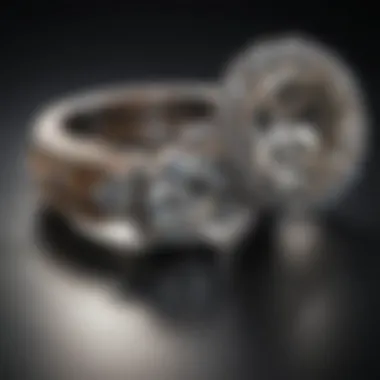
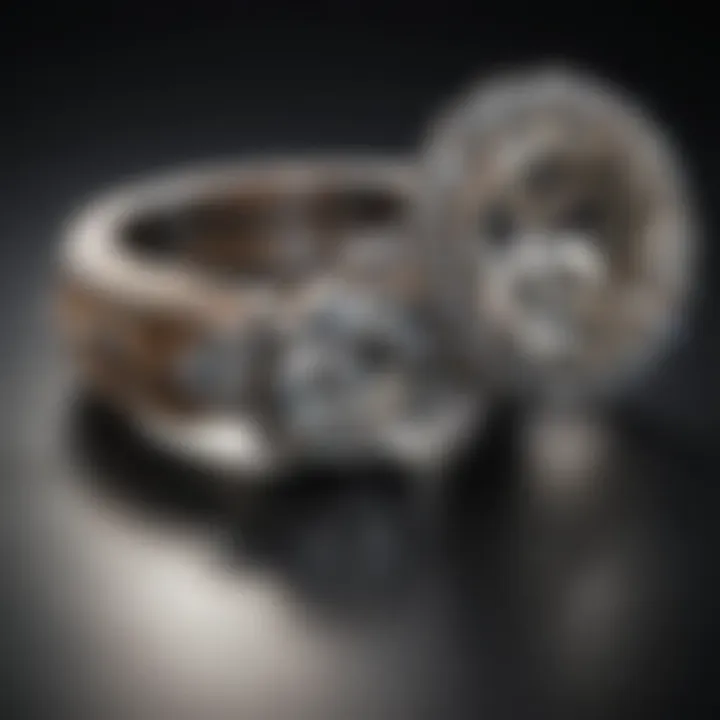
The cost of engagement rings has traditionally been dominated by diamonds, which often carry hefty price tags that can put a serious dent in one’s wallet. On the flip side, crystals open a whole new world of affordability.
For instance,
- Cubic Zirconia can start as low as twenty to fifty dollars per carat, whereas
- Diamonds can range dramatically from a few thousand to tens of thousands, depending on the cut, clarity, carat, and color.
Crystals are not only more budget-friendly, but they also allow for a striking visual without the financial strain. Couples are finding that they can focus their budget on other aspects of their wedding and future, knowing they didn’t settle for less with their engagement ring choice.
Moreover, given the varying prices of different crystals, selecting among options such as Sapphire or Amethyst can still provide a unique flair while keeping costs in check. This shifts the landscape from just accumulating gemstones to selecting meaningful pieces that resonate with personal stories and values.
Durability Factors
Durability is another crucial factor when considering engagement rings, especially for items intended for daily wear. Diamonds, often hailed as the hardest natural substance on earth, boast a rating of ten on the Mohs scale of mineral hardness. This means they withstand scratches and damage remarkably well. However, various crystals possess different levels of durability that can also suffice depending on their intended use and care regime.
For example:
- Sapphires hold a strong rating of nine on the Mohs scale, making them highly resistant to scratching and a practical alternative for an engagement ring.
- Amethyst, while beautiful, with a rating of seven, may require more cautious handling, as it can be vulnerable to chips or scratches if not cared for.
It's essential to keep in mind that durability can also depend on the type of setting used. A well-designed setting can both enhance the appearance of the crystal and protect it from daily wear risks.
Design Choices for Crystal Ring Engagements
When it comes to crystal ring engagements, the design choices play a vital role. The aesthetic appeal of a ring can say a lot about an individual’s style and personality, and with crystals, the options expand even further. Unlike traditional engagement rings which often favor diamonds, crystal rings offer a palette of colors, shapes, and settings that can reflect deeper meanings or unique stories.
The beauty of these rings lies in their versatility. For instance, a rose quartz ring set in a vintage-style band can evoke romantic sentiments. On the other hand, a lapis lazuli stone can add a sophisticated touch to a modern setting. Choosing the right design enhances not just the appearance but also the significance behind the piece, making it not just an accessory but a cherished memento.
Settings That Enhance Crystals
The right setting is crucial when showcasing the unique beauty of crystal engagement rings. Settings not only secure the stone but also affect how light interacts with it, highlighting the crystal's vibrant colors and clarity. For example, a halo setting can amplify the main stone’s size and sparkle, creating an illusion of grandeur.
Here are some popular settings for crystals:
- Solitaire: A single stone that stands out prominently, perfect for showcasing the size and quality of the crystal.
- Three-stone: Symbolizes the past, present, and future, making it a meaningful choice.
- Channel settings: Incorporate smaller stones alongside the main crystal, creating a cohesive look.
Different settings can also affect the comfort and durability of the ring, so it’s worth considering how one’s lifestyle might impact the choice of design.
Customization Options
Personalized touches go a long way in making a crystal engagement ring unique. Customization options allow couples to create a piece that resonates with their love story.
Engraving
Engraving is a cherished method for adding a personal touch. Couples often choose to engrave names, initials, or meaningful dates inside the band. This act of personalization shows thoughtfulness and commitment.
A key characteristic of engraving is its subtlety; it’s intimate, often hidden from view but deeply significant. This element makes it popular among those wishing to convey their love discretely.
However, it’s important to consider the ring's band width. A very thin band might not allow for elaborate designs, while a broader band offers more space for creativity and deeper engravings. All in all, engraving solidifies the bond between the wearer and the ring.
Mixed Materials
Using mixed materials in crystal engagement rings is not just a trend—it's an exciting avenue for individuality. Incorporating gold, silver, or even wood can create a fascinating contrast against the brilliance of a crystal.
A key aspect of mixed materials is their ability to blend traditional and contemporary aesthetics, resulting in a ring that stands apart. This is beneficial for those who appreciate both modern designs and classic craftsmanship.
Nevertheless, one must tread carefully when choosing materials to ensure durability. The compatibility of different metals and how they react to each other over time is something to keep in mind. Nevertheless, when executed thoughtfully, mixed materials can create an extraordinary engagement ring that captures the essence of the couple’s journey together.
"A ring isn’t just a piece of jewelry; it’s a representation of one’s journey and commitment. The design and choices behind it speak volumes."
Selecting the right design choices for crystal ring engagements not only enhances beauty but also brings personal significance to an unforgettable moment.
Caring for Crystal Engagement Rings
As alluring as crystal engagement rings can be, they demand a certain level of attention and care to maintain their beauty and integrity. Proper maintenance is not just about retaining their sparkle but also about preserving the unique qualities of the stones. Crystals, unlike traditional diamonds, may have different hardness levels and chemical properties, which means that they require distinct cleaning and storage methods. This section aims to highlight the essence of caring for these stunning pieces and underscores its importance.
Cleaning Techniques
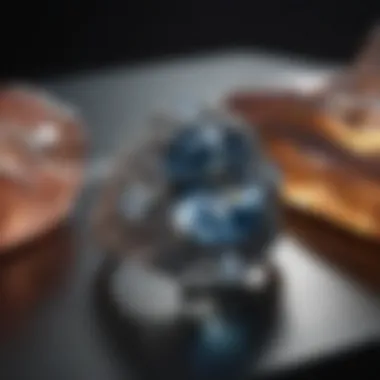
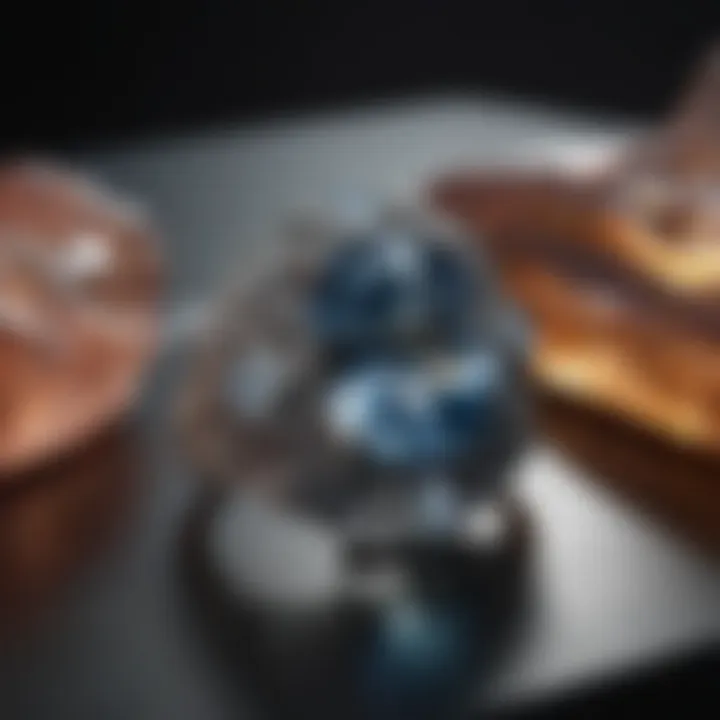
Cleaning your crystal engagement ring is crucial to keep it looking radiant. Many crystal stones are sensitive to harsh chemicals and abrasive materials that can damage their surface. Here are some simple, effective techniques to bring back the shine:
- Gentle Soap Solution: Mix a few drops of mild dish soap with warm water. Soak the ring in this solution for about 10-15 minutes. Using a soft toothbrush, gently scrub the crevices to remove dirt and oils. Avoid any brushes that are too hard, as they can scratch the crystals.
- Ultrasonic Cleaners: While these devices are often used for more robust gemstones, some clear quartz and tougher crystals can handle ultrasonic cleaning. Still, it's best to check the individual properties of your stone before using this method.
- Avoid Harsh Chemicals: Ensure you steer clear of cleaning agents that contain bleach or ammonia. These can lead to discoloration or even damage the crystal. Natural alternatives, like baking soda and vinegar, might also be too harsh for softer crystals, such as amethyst or topaz.
Storage Tips
Storage is another essential aspect of caring for your crystal engagement ring. Proper storage helps protect crystals from scratches or breaks. Here are some effective tips to keep your ring safe:
- Use a Soft Pouch: When you're not wearing your ring, store it in a soft fabric pouch or a jewelry box lined with cloth. This protects the stones from dust and minimizes the risk of scratches from other jewelry.
- Keep Away from Sunlight: While many crystals enjoy a bit of sunlight, prolonged exposure can fade colors over time. Store your ring in a cool, dark place where it's not exposed to direct sunlight for long durations.
- Separate Storage: Try to keep your crystal engagement ring away from other jewelry, especially metal pieces that can scratch the surface. Consider using separate compartments in your jewelry box or designated trays.
"Caring for crystal engagement rings is not merely about upkeep; it's about preserving memories intertwined with love and commitment."
In summary, the care of crystal engagement rings is vital for maintaining their luster and protecting their unique charm. By employing gentle cleaning techniques and prudent storage practices, owners can ensure that their crystal engagement ring remains a beautiful symbol of their love. With ongoing attention to proper maintenance, the rings can continue to dazzle for years to come.
Celebrities Who Favor Crystal Engagement Rings
In recent years, the engagement ring landscape has shifted significantly, with many celebrities opting for crystal rings over traditional diamond options.
These choices not only reflect personal style but also resonate with deeper meanings and values that resonate with fans and admirers. When well-known figures embrace alternative gemstones, it can set off trends and encourage fans to reconsider their options.
The decision of a celebrity to wear a crystal engagement ring illustrates a mere preference; it often embodies a statement against convention. Choosing a crystal often symbolizes individuality and authenticity, qualities that many contemporary couples aspire to when sealing their commitment.
Notable Examples
Consider Megan Fox, who was seen rocking an engagement ring featuring an emerald cut crystal. This instantly sparked enthusiasm among fans, showcasing that beauty doesn't always have to stem from diamonds.
Another prominent case is Miley Cyrus, who opted for a unique ring with various colored sapphires. Her choice highlights a personal touch and a nod towards her vibrant personality.
Let's not overlook Katy Perry, whose engagement ring sports a pink diamond. Although technically not a crystal in the traditional sense, her choice accentuates the beauty of colored stones, broadening the scope of what an engagement ring can encompass.
Then there’s Emma Stone, who has been frequently linked to rings embedded with stunning amethysts. This choice not only makes a bold design statement but also embraces the metaphysical properties often associated with amethyst.
"Celebrity choices inevitably fuel consumer interest in alternative engagement options, pushing boundaries and challenging norms."
Ultimately, the preferences of high-profile individuals can lead to a broader acceptance and appreciation of crystal engagement rings, helping to guide the tastes of a discerning public.
In sum, the spotlight on celebrities favoring crystal engagement rings enhances cultural appreciation for these unique stones. For gemstone enthusiasts, collectors, and jewelry designers, understanding these choices can provide insight into ongoing trends and evolving tastes in the realm of engagement jewelry.
The Future of Crystal Engagement Rings
The world of engagement rings is evolving, with crystal rings gaining traction among couples seeking something unique. As we move further into the 21st century, the desire for authenticity and individuality becomes increasingly central. Crystal engagement rings are not just a trend; they symbolize personal stories and values, allowing for deeper connections. Considering how society’s values shift towards sustainability and ethical choices, the future of crystal engagement rings reflects these priorities.
One can expect advances in the craftsmanship of crystal rings, leading to innovative designs that appeal to both aesthetic and emotional sensibilities. We’re witnessing a growing demand for personalized gem settings and unique cuts that resonate with a couple’s journey together. Investing in crystal engagement rings does not merely mean stepping away from traditional diamonds; it signifies embracing a narrative rich with meaning and intention.
Emerging Trends
In the realm of crystal engagement rings, several trends are surfacing that capture the essence of modern love and commitment.
- Eco-Conscious Choices: As environmental awareness grows, more couples are opting for eco-friendly options. Crystals such as lab-created sapphires or ethically sourced amethysts offer beautiful alternatives without the ecological impact tied to traditional mining.
- Vintage and Antique Styles: There’s a resurgence of interest in vintage designs. Whether it's a classic look or a more intricate art-deco piece, these styles enhance the character of the crystal, making each ring distinct and telling a story of its own.
- Bold Colors: Gone are the days of sticking to traditional hues. Couples today are leaning toward bolder colors. Vivid turquoise or rich pink garnet rings are becoming popular, reflecting the wearers' personalities.
- Combination Materials: Mixing different materials is also in vogue. Combining metals like rose gold with crystal enhances the visual appeal. These combinations can spotlight the crystal itself, making it the star of the show.
"Crystals are the unsung heroes of the jewelry world, often overlooked for their flashier diamond counterparts. However, their unique properties and stories resonate with many looking for authentic engagement choices."
As both designers and consumers find innovative ways to incorporate crystals into jewelry, it seems clear that the future holds bright prospects for those looking to celebrate commitment in unique, meaningful ways. Whether it’s embracing bold designs or adhering to eco-conscious values, the world of crystal engagement rings is ripe for exploration and personal expression.
Epilogue
Wrapping up the discussion around crystal engagement rings, it becomes clear that these stunning alternatives to traditional diamonds hold a deeper significance than mere aesthetics. Crystal rings are not just a trend but a reflection of personal taste and beliefs. Their unique properties and rich symbolism provide couples with choices that resonate deeply with their values and preferences.
When considering a crystal engagement ring, one must weigh multiple aspects. The emotional aspect is paramount; many people believe that different crystals carry specific energies or meanings. For example, a rose quartz symbolizes love and compassion, while an amethyst is often associated with tranquility and balance. It’s vital for lovers to choose a stone that speaks to their relationship.
Cost is another big player in the decision-making process. Crystals are often more wallet-friendly than diamonds. A high-quality crystal can be a more budget-friendly option without sacrificing beauty. This makes it practical for those who want to invest in something unique without breaking the bank.
Also, the design choices available today open the door for personalization. The settings and options like engraving or mixed materials give couples a blank canvas to express their love story. These rings can be crafted to suit individual tastes, making them as unique as the couple themselves.
Making Informed Choices
Choosing an engagement ring, especially one with a crystal, should be an experience full of joy and intention. Here are some essential considerations to ensure the decision aligns with personal preferences and relationship values:
- Research the stones: Understand the various types of crystals and their meanings. Certain stones, like topaz, are not only beautiful but also have significant cultural backgrounds that might resonate with the couple.
- Consider the setting: Think about what setting complements the stone best. Some settings enhance the stone's natural beauty, while others may overshadow it. Look for settings that showcase the unique characteristics of the crystal.
- Seek expert advice: Don’t hesitate to consult with jewelers who specialize in gemstone jewelry. Their insights can uncover details you may miss, such as the proper maintenance for different crystals.
- Weigh personal values: Incorporate values and beliefs into the decision. If ethical sourcing is a concern, ensure the stone was obtained without impacting the environment or communities.
Ultimately, making an informed choice fosters a deeper connection to the ring and, by extension, the marriage that it symbolizes. Regardless of the specifics, the most important aspect lies in the meaning behind the choice—a reflection of the couple’s journey.







